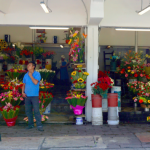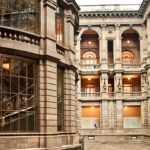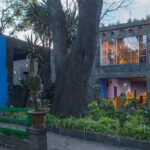
Museo de el Carmen was founded in 1938. It reopened as a museum in the well-preserved 17th-century grounds of the El Carmen monastery and college. The artistic value of exhibitions are notable. The museum collection includes some of the best examples of Sacred Art. This includes Baroque altarpieces in the chapels, reliquaries, crypts, sculptures, paintings, and even the mummified bodies of some of the Carmelite friars.
The El Carmen Monastery College, originally for the Discalced Carmelites, provided for an entirely hermetic life and secluded from the society. The temple was dedicated to the Catholic saint, San Ángel Martir, for which the one-time town and the neighborhood of today were named.
Fray Andres de San Miguel, a friar member of the order, was well-experienced in construction. He took charge of the design and building of the project and construction began in 1615. In accordance with the order’s belief in austerity, decoration was simple. But visitors today are astounded at the sheer beauty of the site.
The museum is divided into ten sections. These begin with the Students’ Patio, vestibules that provide access to the main building, an access portal, a border between the spiritual and mundane life. The brothers were seldom allowed to leave the college grounds.
Once inside the main building, an introduction hall welcomes guests to the permanent exhibitions and gradually unveils the story of the monastery and life here. The Cloister Patio, surrounded with 20 massive white arches encloses a Talavera tile fountain in the middle. This would have been the only outdoors allowed to many of the inhabitants.
In the Sacristy, a magnificent golden and polychromic mudejar-mannerist inspired ceiling is crowned with a work by colonial, Artist Villalpando. He faithfully depicts the origins of the order.
Beneath the main building, the Mortuary Chapel is heavily decorated and a vaulted underground hall hides away the crypts of order members and benefactors. These have remained nearly untouched despite several plunders suffered by the complex.
The Domestic Chapel contains a unique Salomonic Baroque altarpiece. Images of Saint Anne and Saint Joachim flank the chapel. They contrasts with the austerity of the order and this was the only place where members could hear mass.
Carmelite passion for knowledge resulted in a vast library said to have once contained more than 12,000 volumes. Most were lost to looting over the centuries. A large formal hall bears witness to the passion, but today it contains larger paintings and other art works.
An aqueduct patio and house are usually the final stop on a visit that transports visitors to a time gone by. The confined lives of the Carmelite monks led to not just studies, but to the orchards that today make up the Chimalistac neighborhood. The order’s expertise covered their expenses and earned them recognition. It’s a reputation persisting even today in the life of the greater San Ángel neighborhood.
Visits to Museo de el Carmen are easy from Metro Barranca del Muerto, or from the metrobus, La Bombilla. Some will also take advantage of the walk through the beautiful Chimalistac neighborhood when arriving from Metro Miguel Ángel de Quevedo. It’s a great way to begin a visit to many of the other sites in San Ángel.
 elcarmendifusion@gmail.com
elcarmendifusion@gmail.com
 +52 (55) 5616 1177
+52 (55) 5616 1177
 http://www.elcarmen.inah.gob.mx/
http://www.elcarmen.inah.gob.mx/

0.14 kms.

0.27 kms.

The National Art Museum in Mexico City's Centro Histórico is always going to be a holiday highlight.

Always one of the most popular museum's in the City, the Casa Azul just keeps getting better.

One of the City's most celebrated museums, it's a Coyoacán treasure.

Bellas Artes has long been an iconic symbol of Mexico City's culture, artistry, and the performance arts.

One of Mexico City's favorite Modern Art Museums, MAM is your best bet for the Modern and the Fun!